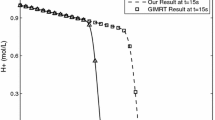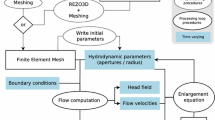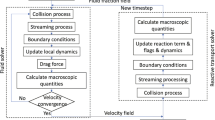Abstract
The distinct element method was used to simulate chemical–mechanical–hydraulic processes that occur during serpentinization (volume-increasing hydration) within the oceanic lithosphere. The proposed model considers water transported in two ways: advective flow along fractures and through matrices. Variations in fracture pattern and system evolution were examined using two nondimensional parameters: the ratios of the rates of flow in fracture (Ψ F) and matrix (Ψ M) to the surface reaction rate. In cases of fixed Ψ F and Ψ M with sufficiently low reaction rates, the fracture pattern is not dependent on the surface reaction rate. Otherwise, the fracture pattern varies systematically as a function of Ψ F and Ψ M. At low Ψ F (≤1) and low Ψ M (≤1), the reaction proceeds from the boundaries inward and forms fine fractures layer by layer. At high Ψ F (≥10,000) and low Ψ M (≤10), the reaction proceeds from the boundaries inward and forms polygonal fracture networks. As Ψ M increases (>100), the reaction tends to proceed homogeneously from the boundaries without fracturing. A comparison of natural and simulated textures reveals that the following conditions are necessary to develop mesh textures during serpentinization in the oceanic lithosphere. (1) The surface reaction rate must be similar to or higher than the fluid flow rate in the matrix (or than the diffusive transport of water), and much lower than the fluid flow rate along fractures. (2) Original olivine grain boundaries act as pathways for fluid transport; these pathways may result from thermal or tectonic stress-induced cracking prior to serpentinization.









Similar content being viewed by others
References
Andreani M, Mevel C, Boullier A-M, Escartin J (2007) Dynamic control on serpentine crystallization in veins: constraints on hydration process in oceanic peridotites. Geochem Geophys Geosyst. doi:10.1029/2006GC001373
Bach W, Garrido CJ, Paulick H, Harvey J, Rosner M (2004) Seawater–peridotite interactions: first insights from ODP Leg 209, MAR 15 N. Geochem Geophys Geosyst. doi:10.1029/2004GC000744
Bach W, Paulick H, Garrido CJ, Ildefonse B, Meurer WP, Humphris SE (2006) Unraveling the sequence of serpentinization reactions: petrography, mineral chemistry, and petrophysics of serpentinites from MAR 15 N (ODP Leg 209, Site 1274). Geophys Res Lett 33:L13306. doi:10.1029/2006GL025681
Boillot G, Grimaud S, Mauffret A, Mougenot D, Kornprobst J, Mergoil-Daniel J, Torrent G (1980) Ocean-continent boundary off the Iberian margin: a serpentinite diapir west of the Galicia Bank. Earth Planet Sci Lett 48:23–34
Bostock MG, Hyndman RD, Rondenay S, Peacock SM (2002) An inverted continental Moho and serpentinization of the forearc mantle. Nature 417:536–538
Carlson WD (1991) Competitive diffusion-controlled growth of porphyroblasts. Miner Mag 55:317–330
Christensen NI (2004) Serpentinites, peridotites, and seismology. In: Ernst WG (ed) Serpentine and serpentinites: mineralogy, petrology, geochemistry, ecology, geophysics, and tectonics. Bellwether Publishing, Columbia, pp 503–524
Coleman RG, Keith TE (1971) A chemical study of serpentinization—Burro Mountain, California. J Petrol 12:311–328
Emmanuel S, Berkowitz B (2006) Suppression and stimulation of seafloor hydrothermal convection by exothermic mineral hydration. Earth Planet Sci Lett 243:657–688
Evans BW (2010) Lizardite versus antigorite serpentine: magnetite, hydrogen, and life (?). Geology 38:879–882
Farough A, Moore DE, Lockner DA, Lowell RP (2016) Evolution of fracture permeability of ultramafic rocks undergoing serpentinization at hydrothermal conditions: an experimental study. Geochem Geophys Geosyst 17:44–55
Farver JR, Yund R (1999) Oxygen bulk diffusion measurements and TEM characterization of a natural ultramylonite: implications for fluid transport in mica-bearing rocks. J Metamorph Geol 17:669–683
Foustoukos DI, Seyfried WE Jr (2004) Hydrocarbons in hydrothermal vent fluids: the role of chromium-bearing catalysts. Science 304:1002–1005
Godard M, Luquot L, Andreani M, Gouze P (2013) Incipient hydration of mantle lithosphere at ridges: a reactive-percolation experiment. Earth Planet Sci Lett 371:92–102
Hacker BR, Abers GA, Peacock SM (2003) Subduction factory 1. Theoretical mineralogy, densities, seismic wave speeds, and H2O contents. J Geophys Res 108(B1):2029. doi:10.1029/2001JB001127
Hirauchi K, Katayama I, Uehara S, Miyahara M, Takai Y (2010) Inhibition of subducting thrust earthquakes by low-temperature plastic flow in serpentine. Earth Planet Sci Lett 295:349–357
Hyndman RD, Peacock SM (2003) Serpentinization of the forearc mantle. Earth Planet Sci Lett 212:417–432
International Association for the Properties of Water and Steam (2014) ASME international steam tables for industrial use, 3rd edn. ASEM, New York
Iyer K, Jamtveit B, Malthe-Sørenssen A, Feder J (2008) Reaction-assisted hierarchical fracturing during serpentinization. Earth Planet Sci Lett 267:503–516
Iyer K, Rüpke LH, Morgan JP (2010) Feedbacks between mantle hydration and hydrothermal convection at ocean spreading centers. Earth Planet Sci Lett 296:34–44
Jamtveit B, Austrheim H, Malthe-Sørenssen A (2000) Accelerated hydration of the Earth’s deep crust induced by stress perturbations. Nature 408:75–78
Jamtveit B, Malthe-Sørenssen H, Kostenko O (2008) Reaction enhanced permeability during retrograde reactions. Earth Planet Sci Lett 267:620–627
Jamtveit B, Putnis CV, Malthe-Sørenssen A (2009) Reaction induced fracturing during replacement processes. Contrib Miner Petrol 157:127–133
Jamtveit B, Kobchenko M, Austrheim H, Malthe-Sørenssen A, Røyne A, Svensen H (2011) Porosity evolution and crystallization-driven fragmentation during weathering of andesite. J Geophys Res 116:B12204
Katayama I, Kurosaki I, Hirauchi K (2010) Low silica activity for hydrogen generation during serpentinization: an example of natural serpentinites in the Mineoka ophiolite complex, central Japan. Earth Planet Sci Lett 298:199–204
Kelemen PB, Hirth G (2012) Reaction-driven cracking during retrograde metamorphism: olivine hydration and carbonation. Earth Planet Sci Lett 345–348:81–89
Kelley DS, Karson JA, Blackman DK, Früh-Green GL, Butterfield DA, Lilley MD, Olson EJ, Schrenk MO, Roe KK, Lebon GT, Rivizzigno P, AT3-60 Shipboard Party (2001) An off-axis hydrothermal vent field near the Mid-Atlantic Ridge at 30 N. Nature 412:145–149
Klein F, Bach W, Jöns N, McCollom T, Moskowitz B, Berquó T (2009) Iron partitioning and hydrogen generation during serpentinization of abyssal peridotites from 15 N on the Mid-Atlantic Ridge. Geochim Cosmochim Acta 73:6868–6893
Klein F, Grozeva N, Seewald JS, McCollom TM, Humphris SE, Moskowitz B, Berqúo T, Kahl W-A (2015) Experimental constraints on fluid-rock reactions during incipient serpentinization of harzburgite. Am Miner 100:991–1002
Koyama T, Jing L (2007) Effects of model scale and particle size on micro-mechanical properties and failure processes of rocks—a particle mechanics approach. Eng Anal Bound Elem 31:458–472
Lasaga AC (1998) Kinetic theory in earth sciences. Princeton University Press, Princeton
Llana-Fúnez S, Wheeler J, Faulkner DR (2012) Metamorphic reaction rate controlled by fluid pressure not confining pressure: implications of dehydration experiments with gypsum. Contrib Miner Petrol 164:69–79
Ludwig KA, Shen C-C, Kelley DS, Cheng H, Edwards RL (2011) U–Th systematics and 230Th ages of carbonate chimneys at the lost city hydrothermal field. Geochim Cosmochim Acta 75:1869–1888
Macdonald AH, Fyfe WS (1985) Rate of serpentinization in seafloor environments. Tectonophysics 116:123–135
Malthe-Sørenssen A, Jamtveit B, Meakin P (2006) Fracture patterns generated by diffusion controlled volume changing reactions. Phys Rev Lett 96:245501
Malvoisin B (2015) Mass transfer in the oceanic lithosphere: serpentinization is not isochemical. Earth Planet Sci Lett 430:75–85
Malvoisin B, Brunet F (2014) Water diffusion-transport in a synthetic dunite: consequences for oceanic peridotite serpentinization. Earth Planet Sci Lett 403:263–272
Malvoisin B, Carlut C, Brunet F (2012a) Serpentinization of oceanic peridotites: 1. A high-sensitivity method to monitor magnetite production in hydrothermal experiments. J Geophys Res 117:B01104
Malvoisin B, Brunet F, Carlut J, Rouméjon S, Cannat M (2012b) Serpentinization of oceanic peridotites: 2. Kinetics and processes of San Carlos olivine hydrothermal alteration. J Geophys Res 117:B04102
Martin B, Fyfe WS (1970) Some experimental and theoretical observations on the kinetics of hydration reactions with particular reference to serpentinization. Chem Geol 6:185–202
McCollom TM, Bach W (2009) Thermodynamic constraints on hydrogen generation during serpentinization of ultramafic rocks. Geochim Cosmochim Acta 73:856–875
McCollom TM, Seewald JS (2001) A reassessment of the potential for reduction of dissolved CO2 to hydrocarbons during serpentinization of olivine. Geochim Cosmochim Acta 65:3769–3778
Miller SA, Nur A (2003) A fluid-pressure feedback model of dehydration reactions: experiments, modeling, and application to subduction zones. Tectonophys 370:241–251
Müntener O (2010) Serpentine and serpentinization: a link between planet formation and life. Geology 38:959–960
Nakajima J, Yoshida K, Hasegawa A (2013) An intraslab seismic sequence activated by the 2011 Tohoku-oki earthquake: evidence for fluid-related embrittlement. J Geophys Res 118:3492–3505
Ogasawara Y, Okamoto A, Hirano N, Tsuchiya N (2013) Coupled reactions and silica diffusion during serpentinization. Geochim Cosmochim Acta 119:212–230
Okamoto A, Shimizu H (2015) Contrasting fracture patterns induced by volume-increasing and -decreasing reactions: implications for the progress of metamorphic reactions. Earth Planet Sci Lett 417:9–18
Okamoto A, Ogasawara Y, Ogawa Y, Tsuchiya N (2011) Progress of hydration reactions in olivine–H2O and orthopyroxenite–H2O systems at 250 °C and vapor-saturated pressure. Chem Geol 289:245–255
Oyanagi R, Okamoto A, Hirano N, Tsuchiya N (2015) Competitive hydration and dehydration at olivine-quartz boundary revealed by hydrothermal experiments: implications for silica metasomatism at the crust-mantle boundary. Earth Planet Sci Lett 425:44–54
Plümper O, Røyne A, Magrasó A, Jamtveit B (2012) The interface-scale mechanism of reaction-induced fracturing during serpentinization. Geology 40:1103–1106
Pollard DD, Fletcher RC (2005) Fundamentals of structural geology. Cambridge University Press, Cambridge
Potyondy DO, Cundall PA (2004) A bonded-particle model for rock. Int J Rock Mech Min 41:1329–1364
Ranero CR, Morgan JP, McIntosh K, Reichert C (2003) Bending-related faulting and mantle serpentinization at Middle America trench. Nature 425:367–373
Rouméjon S, Cannat M (2014) Serpentinization of mantle-derived peridotites at mid-ocean ridges: mesh texture development in the context of tectonic exhumation. Geochem Geophys Geosyst 15:2354–2379
Røyne A, Jamtveit B, Mathiesen J, Malthe-Sørenssen A (2008) Controls on rock weathering rates by reaction-induced hierarchical fracturing. Earth Planet Sci Lett 275:364–369
Rudge JR, Kelemen PB, Spiegelman M (2010) A simple model of reaction-induced cracking applied to serpentinization and carbonation of peridotiite. Earth Planet Sci Lett 291:215–227
Shimizu H, Murata S, Ishida T (2011) The distinct element analysis for hydraulic fracturing in hard rock considering fluid viscosity and particle size distribution. Int J Rock Mech Min 48:712–727
Ulven OI, Jamtveit B, Malthe-Sørenssen A (2014a) Reaction-driven fracturing of porous rock. J Geophys Res 119:7473–7486
Ulven OI, Storheim H, Austrheim H, Malthe-Sørenssen A (2014b) Fracture initiation during volume increasing reaction in rocks and applications for CO2 sequestration. Earth Planet Sci Lett 389:131–142
Wegner WW, Ernst WG (1983) Experimentally determined hydration and dehydration reaction rates in the system MgO–SiO2–H2O. Am J Sci 283:151–180
Yamasaki T, Seno T (2003) Double seismic zone and dehydration embrittlement of the subducting slab. J Geophys Res 108(B4):2212
Acknowledgments
Kenichi Hirauchi kindly allowed us to use thin sections of Mineoka ophiolite for modeling. We thank N. Tsuchiya, M. Uno and R. Oyanagi for discussion. This study was supported by a Grant-in-Aid for Scientific Research on Innovative Areas (nos. 24109701, 25120005) from the Ministry of Education, Culture, Sports, Science and Technology of Japan, and by a Grant-in-Aid for Challenging Exploratory Research (no. 23654180) and for Scientific Research (no. 16H06347) from the Japan Society for the Promotion of Science awarded to A. Okamoto.
Author information
Authors and Affiliations
Corresponding author
Additional information
Communicated by Othmar Müntener, Editor in Chief.
Electronic supplementary material
Below is the link to the electronic supplementary material.
Rights and permissions
About this article
Cite this article
Shimizu, H., Okamoto, A. The roles of fluid transport and surface reaction in reaction-induced fracturing, with implications for the development of mesh textures in serpentinites. Contrib Mineral Petrol 171, 73 (2016). https://doi.org/10.1007/s00410-016-1288-y
Received:
Accepted:
Published:
DOI: https://doi.org/10.1007/s00410-016-1288-y




